When the Irish famine ships arrived in Boston in the 1840s, tens if not hundreds of thousands of immigrants from Ireland already made their mark on New England.
By 1790, there were 400,000 Americans of Irish birth or ancestry out of a population of 3.9 million. Half were Scots-Irish from Ulster, the other half were Catholics from southern Ireland.
Before the American Revolution, the Irish population in America was second only to the English, with 70 Irish settlements in the British colonies.
It is far more difficult to find information about the Irish Catholics of colonial New England than about the Scots-Irish. Puritans persecuted Catholics, while they more or less tolerated the Scots-Irish. But so absent were Irish Catholics from the historical record that some historians – and a Scots-Irish society – claim few Irish Catholics lived in New England before the Revolutionary War.
It isn’t so. Protestant and Catholic immigrants from Ireland taught the Puritan children, settled the Maine and New Hampshire frontiers, built roads, wharves and warehouses, led armies and became successful merchants. Eight of the 56 signers of the Declaration of Independence had Irish birth or ancestry, as did seven of the 54 framers of the Constitution. They governed states, wrote laws and fought in the Revolution.
The First Great Migration
The first great migration to New England began in 1628, when King Charles granted a new charter to the Massachusetts Bay Colony. Between 1629 and 1640, 20,000 people crossed the Atlantic. They weren’t all Puritans. Immigration fever had caught hold of Anglicans, Irish Catholics and Scots-Irish Protestants. They came to escape religious persecution, high rents, crop failures and poverty.
The Puritans in charge scrutinized the new arrivals. ‘Persons unmeete to inhabit here’ were sent back over the Atlantic. And since the Puritans wrote history from their own intolerant viewpoint, the Anglican and Irish experience of that era is less well – and less accurately – known.
In 1640 the great migration ended with the outbreak of the English Civil War, and some of the Massachusetts Bay colonists returned to England to fight with the Parliamentarians. New England fell into an economic depression, and the first wave of immigration ended for at least a decade.
By 1650, a steady stream of Boston-bound ships began to leave Ireland filled with redemptioners – indentured servants who agreed to near-slavery for seven years in exchange for passage, food, shelter and clothing. That stream would become a flood.
Scots-Irish
King James I had encouraged Scottish Presbyterians to move to Ulster in the 16th century as a cure for overpopulation and to discourage further Irish rebellion. They lived there for generations, where they clashed with the Catholics, but prospered from the manufacture of textiles.
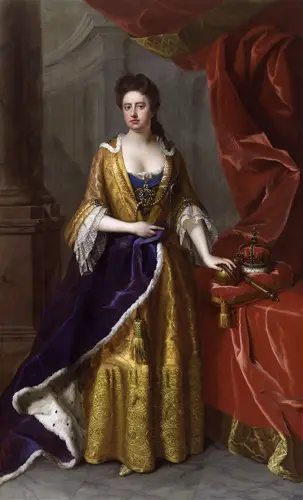
Queen Anne
Then in 1698 the English government banned the export of wool, destroying the Ulster wool industry. Crops failed. And four years later, the intolerant Anglilcan Anne inherited the throne. She began persecuting Presbyterians as well as Catholics, inspiring an exodus.
The first major migration of Scots-Irish to America was a group that came with Rev. James McGregor from County Londonderry to Boston in 1718. Many of them moved to New Hampshire, establishing the town of Londonderry.
The Puritans accepted the Scots-Irish because of their Protestant religion and because they arrived in organized groups, often led by clergy. Plus, they were useful as pioneers in the forests of New Hampshire and along the Kennebec and Eastern rivers in Maine. There they acted as buffers from Indians.
Many place names in Maine and New Hampshire reflect their Scots-Irish roots: Derry, Antrim and Londonderry, N.H.; Belfast and Limerick, Maine; Colrain, Mass.; and Londonderry, Vt. (Maine today ranks seventh in the percentage of residents of Scots-Irish descent. )
As individuals, though, the Scots-Irish didn’t always receive a welcome. Their Presbyterian meetinghouse was burned in Worcester, an early harbinger of Know Nothingism.
Dangerous Irish Catholics
The Puritans treated Irish Catholics even worse. They wouldn’t let people own property or carry on a business in Boston unless they took the Oath of Allegiance to some Protestant faith.
In 1723, Boston selectmen issued an order that anyone who came from Ireland within the past three years must register with the town because they might become a town charge or ‘otherwise prejudicial to the well fair and prosperity of the place.’
A notice from a Boston town meeting in 1746 warns that several Catholics reside in the town ‘and it may be very Dangerous for such persons to Reside here in Case we should be attack’d by an Enemy.’ Three days later, after a committee investigation, the selectmen reported they suspected ‘a considerable number of Roman Catholics to be now in Town.’
From the 1740s to the 1760s, rival gangs fought on Nov. 5 over the right to burn the Catholic pope in effigy, Pope Night.
Oath of Allegiance
The Catholics kept out of the Puritans’ way and they stayed out of the historical record. Historian Michael O’Brien argues that many Irish Catholics abandoned their faith and became Baptists and Methodists. “There was no alternative for them,” he concluded.
In 1678, the men who took the Oath of Allegiance before the Massachusetts governor had such Irish Catholic names as Murphy, Dempsey, Casey, O’Kelly, Hearn and Collins.
Many of the Irish Catholics came as indentured servants. They sailed from Dublin, Cork and Waterford to Marblehead, Boston, Providence and Piscataqua, Maine. Some came from Galway via Newfoundland, where they fished.
Some came by way of Barbados, where Oliver Cromwell had deported 50,000 Irish Catholic peasants as indentured servants in the mid 17th century. Ann Glover was one. She was living in Boston by 1680 and hanged on Nov. 16, 1688 as a witch. The proof: she could only say the Lord’s Prayer in Gaelic.
Soldiers and Schoolmasters
Another indentured servant from Ireland was Matthew Lyon, born in Dublin on July 14, 1749.. He emigrated to Woodbury, Conn., in 1764, and he fought in the Revolution. Afterward he was elected to Congress, where he started the first brawl.
With no love of the English, Irish immigrants and their descendants played major roles in achieving American independence. John Hancock was Scots-Irish; so was George Washington’s trusted adviser, Gen. Henry Knox. A signer of the Declaration of Independence, Matthew Thornton, came from non-Ulster Ireland – in Limerick – though he lived in Londonderry, N.H.
More than 1,200 officers in the American armies came from Ireland, including Gen. John Sullivan, later a New Hampshire governor. And the muster roles of the Continental Army and Navy are filled with Hibernian names. There are 695 Kellys alone who fought against the British.
So many fought, in fact, that one British general testified at the House of Commons that ‘half the rebel Continental Army were from Ireland.’
St. Patrick’s Day
The Continental Army also celebrated St. Patrick’s Day in 1778 at Valley Forge. According to an account of the incident, some of the Pennsylvania German volunteers made a stuffed scarecrow they called a ‘paddy’ and hoisted it on a pole. It attracted a crowd of angry Irish soldiers, who threatened a riot. Their officers couldn’t restore discipline.
Then George Washington arrived on horseback and tried to calm the outraged Irishmen. Finally he said, “I, too, am a lover of St. Patrick’s day, and will settle the affair by making all the army keep the day.”
He then ordered a whiskey ration to every man in camp, and the soldiers long remembered the day as a pleasant episode in camp life.
There’s more to Irish history than the Great Hunger. Learn about the food traditions that the Irish brought to America—and then brought back to Ireland. Available from Amazon in paperback and ebook. Click here.
This story was updated in 2023.
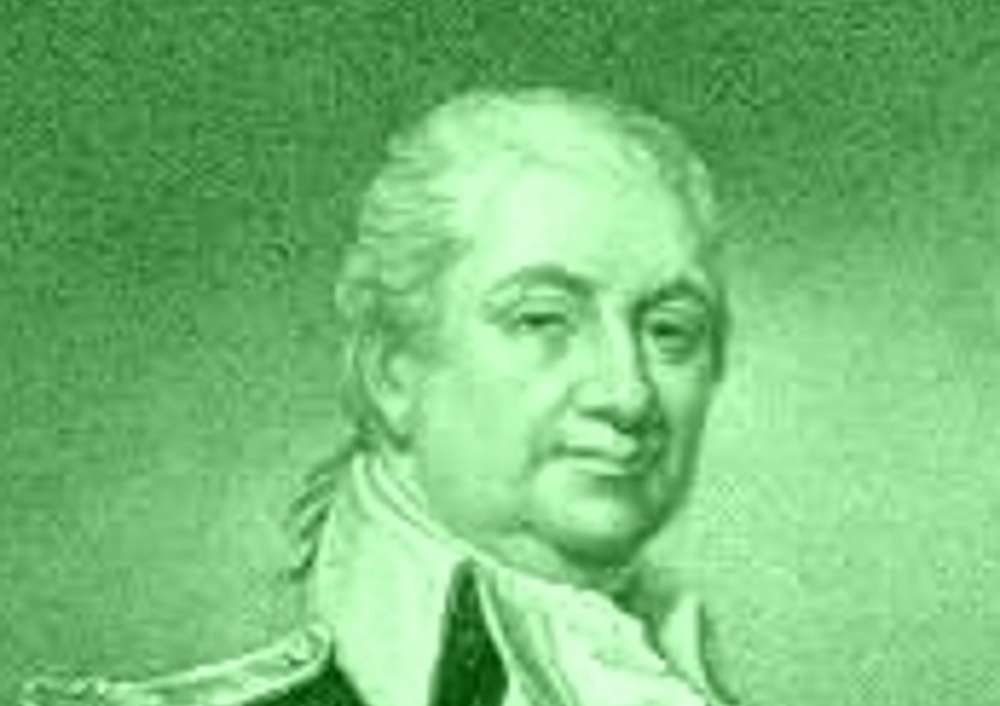

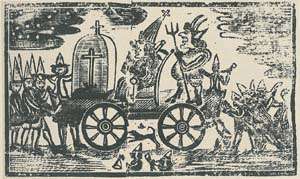
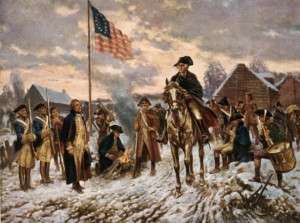
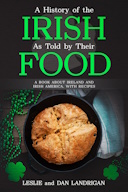

21 comments
He is overweight.
Yes, he was, but at that time it was a sign of prosperity.
Had a great dinner of corned beef and cabbage last night to celebrate St. Patrick’s Day!!
Very interesting – but isn’t the spring of 1778 in Valley Forge when 2,000 soldiers died in camp of “Camp fever” and were buried in unmarked graves – it would be at same time as this article talks about. My 7th great grandfather died in camp of “camp fever”/ So many thousands died, Washington did not want the enemy to learn of it, hence the mass graves unmarked.
This looks nothing like Washington. Bad painter, his arms are way too short for a really tall man.
^Pat Epp, it’s actually Henry Knox. His arms do look a little short, though.
There are so many historical fictions in this article that it’s hard to know where to begin, or if one should even bother beginning at all.
For one thing, using phrases like “Irish Catholic names” reeks to high heaven of Northern Irish sectarianism. Michael O’Brien attempted the same stunt in A Hidden Phase of American History, where he made dubious links to last names and religion, in an effort to show that Irish Catholics had been more numerous in the colonies than what was otherwise assumed. But most contemporary historians of our day have rebuked O’Brien for this practice and discredited the idea that Catholics were present in large numbers in British America. There were Irish in the colonies, to be sure, and many of them had names traditionally associated with Ireland (not the Scottish Lowlands). But almost all of them were Protestant, either by conversion or on arrival.
And, in any event, if we’re going to label such names “Irish Catholic”, including the name Fitzgerald on that list is sure to inspire a few chuckles from the people who live in Ireland, who tend to associate Norman and even Norman-sounding names with centuries of English rule. The Fitzgeralds were made Dukes of Leinster in the 18th Century, and were the most prominent family of the Protestant Ascendancy — the very establishment that stripped rights away from Catholics through a series of harsh penal laws. Just the other day I was reading an article in the Irish Times about the descendants of these Dukes (found here: https://www.irishtimes.com/culture/books/the-fitzgeralds-of-carton-house-a-deeply-dysfunctional-family-the-decline-and-fall-of-the-dukes-of-leinster-1.1837003), and I couldn’t help but notice that the commentators from Ireland considered this family not only Protestant (which they were, if you consider Anglicanism to be a Protestant faith) but English.
But perhaps the most glaring of the aforementioned errors is your assumption that the “Scots-Irish” and “Catholic Irish” were two inviolable ethnic borders in the 18th Century and perceived as such by contemporaries of the period. I would refer you to the work of Kerby Miller, and specifically his writings on the “Scotch-Irish Myth”, to correct this postulation. Miller is by all hands considered the foremost expert on Irish-American immigration history, and the scholar who vindicated at least one of Michael O’s arguments, having to do with the diasporic mythology of “Scots-Irish” uniqueness.
Miller found little evidence of frequent use of the term “Scots-Irish” as a description for Ulster immigrants in the 18th Century, and even less evidence of ethnoreligious sectarianism being a central feature in 18th Century Ireland and British America. Presbyterians and Catholics, to be clear, did indeed have their differences, but whatever they were they paled in comparison to the differences between all Irish immigrants (Presbyterian and Catholics) and the Puritan and Anglican settlers on the East Coast. Which is why they settled in Pennsylvania and the frontier in the first place: upon being rejected by the establishment elite, they either ran to the more tolerant Quaker colony or headed for the hills. Miller also found substantial evidence of intermarriage between Irish Protestants and Catholics in the Shenandoah Valley, which absorbed most – if not all – of those Catholics into the Presbyterian faith, and then later on the Baptist and Methodist denominations.
The religious sectarianism between Irish Protestants and Catholics intensified as the 19th Century progressed, well after the American Revolution.
Henry Knox – we have a monument to him on Rt 20 in Wilbraham and Palmer – where he passed thru on Old Boston Post Road.
[…] many place names in Maine and New Hampshire reflect their Scots-Irish roots: Derry, Antrim and Londonderry, N.H.; Belfast and Limerick, Maine; Colrain, Mass.; and Londonderry, […]
[…] in the late 19th century. He has been called the first African-American bishop, though he was three-fourths Irish and nearly everyone thought he was […]
[…] in Westbrook, where his father worked as a pharmacist. He grew up with a mix of French Canadian-Irish good looks, and took up the drums and later the saxophone. After an aborted attempt to enlist in […]
[…] departure from and return to the school incited gossip, however. Suspicions and dislike of Irish Catholics were already well established. There was a bustling trade in anti-Catholic tales at the time, and […]
[…] as a trolley car conductor with dreams of hitting it big in real estate. Her mother, Kittie, was an Irish Catholic who divorced Edgar when Audrey was eight. She had to, she said, because he was having an open […]
[…] Attucks. Samuel Maverick, a 17-year-old, died the next day of his wounds. Patrick Carr, an Irish immigrant, died two weeks […]
[…] more to Irish-American history than the Great Hunger, the Kennedys and ‘No Irish Need Apply.’ Irish Catholics came to New England along with the Puritans, who encouraged the Scots-Irish to settle along the […]
[…] Boston Brahmins had no love for the Irish immigrants who arrived on famine ships during the 1840s. Young Brahmins founded the Immigration Restriction League in 1894 shortly after they graduated […]
[…] Dexter was born in Malden, Mass., on Jan. 22, 1747. The first Dexter had immigrated from Ireland a century before. His family was poor and young Timothy received little […]
[…] Puritans weren’t the only people living in Massachusetts Bay Colony. Anglicans, Huguenots and Catholics, for example, had also immigrated to the New […]
[…] was a case of prejudice and class warfare against Irish Catholics rather than one based on evidence. The Irishman's death – many considered it a legal lynching — […]
[…] You might think New England’s Irish-Catholic history begins with the potato famine. However, you’d be wrong. Eight of the 56 signers of the Declaration of Independence, for example, had Irish birth or ancestry. Find out more about how the Irish made their mark on early New England here. […]
[…] Scots-Irish families first came to Blandford in 1735 and called their settlement ‘New Glasgow.’ They had good reason: The people of Glasgow, Scotland, had promised them a church bell if they named their town after them. […]
Comments are closed.